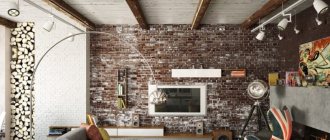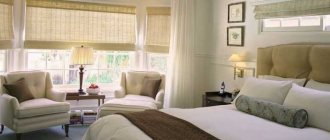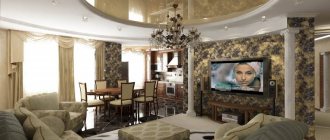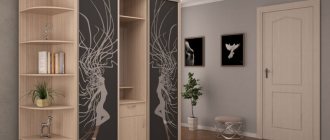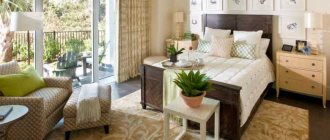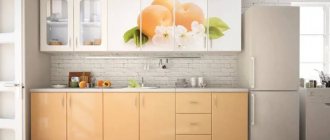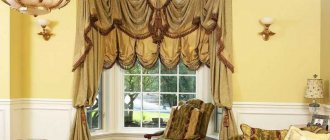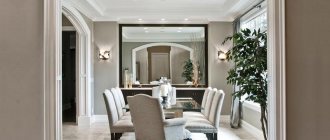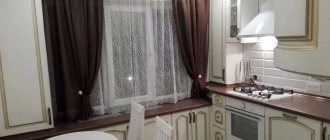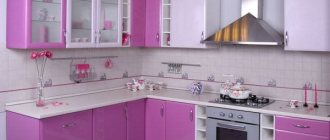To create a modular painting, the drawing is divided into fragments, each of which is applied to canvas and stretched onto a stretcher. There are no standards here; the canvas can be divided vertically, horizontally, diagonally, or “cut” into complex geometric shapes, for example, hexagons. As a rule, these fragments are not inserted into frames, so as not to impede the integrity of the perception of the drawing in its finished form. The number of parts into which the original image will be divided is not regulated; there can be any number of them - it all depends on the designer’s imagination and the size of the canvas.
Important: The lines along which the division occurs must correspond as much as possible to the plot, and the individual fragments must look harmonious.
The size and shape of the fragments can be determined arbitrarily, but there are general recommendations:
- The side of the fragment should not be less than 30 cm;
- The size depends on the area of the room;
- Commonly accepted sizes: width from 1.2 to 1.7 m, height - from 0.8 to 1.2 m.
- As a rule, the shape of the fragment is a square or rectangle.
The use of modern modular paintings in the interior of an apartment allows you to add dynamism, introduce a special “zest”, and make the design truly exclusive, matching your character.
A little history
Modular paintings entered modern life from altars and walls of religious buildings. In the ancient world they were a typical form of church decoration. This manifested itself among both northern and southern peoples. The ancient Celts, Byzantines, and Romans decorated their buildings.
Historians date the appearance of such images to the 9th century AD; the first officially confirmed modular painting is kept in the city of Gdansk, where the National Museum of Poland is located. It was created in 1470 and is called “The Last Judgment”.
Military history museums present all kinds of panoramas of events, each part of which can be considered as a separate work of art. In the modern world, there is a different interpretation of such images, far from military or religious views. Today it is a wonderful room decoration that brings comfort and unique design to the home.
Are segmented paintings harmful to health?
Currently, there is a myth about the dangers of modular paintings for the health of household members - this is complete nonsense! Modern paintings are made from environmentally friendly materials (whether natural or artificial canvas), they are all odorless, non-toxic, and even if they burn, they do not contain harmful vapors in the smoke. So there is no need to be afraid, feel free to purchase composite paintings for your home or make them yourself - please yourself and your loved ones.
One last piece of advice - in general, try not to leave the walls in your apartment or house empty, because... emptiness brings a chill into your home and coziness is lost. That is why modular wall paintings are an excellent and very popular design solution for creating warmth and comfort in a room. Select them correctly, hang them, and you will be aesthetically happy. Good luck!
If the article was useful to you, share it with your friends by clicking on the buttons: Below, leave your comments, suggestions, ask questions, express your opinion - this is very important to us!
Features of modular paintings
Modular paintings are several fragments of a single composition without frames. By changing the position of individual modules and the distance between them, you can achieve the illusion of dynamism and depth. Actually, this is why such a decorative move attracts attention and arouses interest.
There are no clear ideas on how to properly create modular images. Focus on your desires and internal characteristics, experiment. You can arrange parts of the image in any order: horizontally, vertically, or in a square or diagonal shape. In addition, the strict structure can also be violated: turn the creative process into a game, assemble puzzles as you wish, it is only important that the creation is organically woven into the overall design of the space.
As for the dimensions, freedom of choice is also provided here, but in order for the modules to be harmoniously adjusted to the size of the room, we recommend using the following technique. Buy or find newspapers in different formats at home. Carefully attach different options to the wall and choose the one that suits you best. Move around and see how other objects in the room compare to individual newspapers. Having made your final choice, order a painting of the appropriate size.
So what the paintings will look like is up to you. How to deal with individual nuances regarding the varieties of these images, placement in specific rooms and how to do the work yourself - read on.
Which paintings to choose for the living room: features of the room
The size of the room, its geometric shape, should be taken into account both when creating the design of the room and when choosing paintings for it. Pictures should be selected taking into account the following factors.
- Ceiling height. Narrow, thin paintings can visually stretch out space, so they are ideal for spacious rooms with low ceilings, but not for narrow and small ones.
- Room volume. A small room will be visually reduced even more if large images are placed on its walls; medium-sized canvases are perfect here.
- Cluttered space. The more furniture and various interior items there are in the room, the less attention should be distracted by the paintings. They can be in harmony with the rest of the decor, but only if there is a competent approach to choosing their size, shape, and style.
- Image scale. The larger the picture, the greater the viewing angle should be. You should contemplate it from afar (that is, a meter-long canvas looks best from a distance of at least 2 meters from you).
The painting requires more space on the wall, and a wide viewing angle indoors
A painting with a shape close to a square can visually reduce the height of the walls
Avoid large paintings in a small living room
Any “flaws” or illiterate approach to hanging paintings, their form, meaning, can completely ruin the image and the chosen style of the room.
Types of modular paintings for interior
The most common parameter that divides modular paintings into types is the number of elements that make up the canvas. Thus, the following types of modular canvases can be distinguished:
1. Polyptych - consists of 5 or more segments; 2. Penattico: segments of this type consist of 4 parts, arranged in random order; 3. Triptych - a more classic version: a composition of 3 parts; 4. Diptych is a type of modular canvas that can be placed even in the smallest room, since it consists of only 2 elements.
In order for a modular image to fit organically into the finished interior, it is necessary to maintain the style, maintain the composition and provide the correct lighting to the sections. Try to harmonize the texture with the overall style of the room - this will allow you to fully reveal the potential of this accessory and emphasize its charm.
For the bedroom, choose calm and measured landscapes, floral arrangements with shades of bed linen and images of various plants using soft techniques.
Homemade scenes or delicate flowers in the paintings will create a cozy homely atmosphere in the kitchen. In the nursery, choose familiar and pleasant motifs for your baby. These can be cute little animals or scenes from cartoons and fairy tales.
It is also important to choose the right location of modular canvases; the lion’s share of their perception depends on this. For rooms such as living rooms, the classic option is a height of about 150 cm, but the dining room, kitchen or office should be decorated with modular paintings at a height of no more than 1 m.
By choosing the vertical and horizontal arrangement of segments of a modular picture, you can visually adjust the geometry of the room: the first option will make the room taller, and the second will expand the room in length.
Decorators recommend placing modular paintings along the width of your furniture, this will allow them to fit into your room as harmoniously as possible. Using a similar technique, you can make paintings an integral part of the entire decoration of the room. By adding accent or segmented lighting to your painting, you can make it a great decoration for your room. This technique is mainly used for large paintings consisting of large segments.
Module size
Despite the fact that the size of the modules can be anything, there are some rules that will allow you to choose the most successful picture. Fortunately, most products on sale comply with these rules.
- Each side of the module must be at least 30 cm, otherwise it will be difficult to see anything.
- The width of the entire composition is from 1.2 to 1.7 m.
- The height of the composition is from 0.4 to 1.2 m.
There are exceptions to the last two rules.
Important! The lines along which the modules are divided must correspond to the plot so that the modular picture looks harmonious. Don’t forget to evaluate paintings based on this parameter, since stores are full of products where objects are literally chopped into pieces. Such a picture obviously will not become a decoration.
Here the image is not divided very well
In the vast majority of cases, modules have a square or rectangular shape, and modules of different shapes and sizes can be combined in one picture.
The most popular options for combining modules:
- all modules are square, the same size;
- All modules are rectangular and the same size. They can be hung either in one line or in a ladder;
- all modules are rectangular, of different sizes. From such modules, pictures of complex shapes are formed;
- a combination of squares and rectangles allows you to create a whole mosaic on the wall. Such an art object will certainly become the highlight of the room.
Options for the arrangement of modular paintings in the interior
The absence of a frame for each fragment, the presence of “air” between them gives a dynamic perception of the canvas. The following module layouts are distinguished:
- Standard. The modules are located next to each other at the same height.
- Popular. The height of the fragments decreases from the center to the edges, while the hanging fragments decrease in a straight line passing through the center of the individual parts.
- Ladder. Each subsequent fragment is located with an offset from the previous one, and the offset is performed in two directions: from top to right, from bottom to left, etc.
- Diagonal. The modules are suspended in a straight diagonal to the floor.
- Geometric. The individual segments are assembled into geometric shapes: square, oval, circle, polygon.
The variety of types of placement of modular canvases in the interior is not limited to the listed options. It all depends on what decorative effect you want to achieve. The same laws apply here as for other types of interior decoration:
- Vertically elongated compositions will visually “raise” a low ceiling;
- A small room will help to increase the horizontal arrangement of modules;
- Large, bright photographs in a painting can make a small room feel smaller;
- Panoramic shots will create a feeling of spaciousness even in a small room.
How to make a modular painting with your own hands: detailed step-by-step instructions
In order to create a segmented picture yourself, you must strictly adhere to the following rules:
- It is necessary to clearly determine the location of the future installation, i.e. you need to choose an empty wall - the proportions of future parts of the modular picture will depend on its dimensions and dimensions.
- We select a suitable image for the interior of the room, which we cut into the number of parts we need. You can divide both diagonally and vertically; there are no standards here. You can even cut it into complex geometric shapes.
- Then we prepare wooden frames for each part, the dimensions of which should be slightly smaller than the fragments of the picture themselves, for further stretching on them. You can use pieces of plywood or fiberboard instead of wooden blocks. There is also the option to buy a ready-made gallery stretcher, if you have the financial opportunity.
- We stretch each fragment onto a wooden frame and secure it on the reverse side in a convenient way - with furniture nails, a stapler, tape, staples, etc.
- We evenly distribute the resulting fragments of the modular painting on the wall and delight our eyes with the resulting beauty.
Please note: before drilling holes for mounting modular paintings, it is better to mark the locations of their future location, for example with chalk or a simple pencil, in order to visually represent their location in the future. As a last resort, if you are not satisfied with the state of affairs the first time, you have the opportunity to erase everything and redraw it again. Believe me, it's better than re-drilling.
Scraps of beautiful fabrics and posters can serve as images for such homemade paintings; it is possible to print pictures from the Internet. If you have a brush, or you are close to embroidery, then you can use your finished works as painting modules - it will be completely exclusive.
You can also cover them with glass in the future and make overlay frames, so your high-quality, exclusive modular paintings will be protected from external influences. There are also ready-made glass solutions for composite paintings on the market. If you are too lazy to do your own handicrafts, you can use market options, which are also of very decent quality and appearance.
Modular paintings in the interior of different rooms
The main condition for any decorative element is compliance with the theme and color scheme of the overall design concept. Each room has its own “game” rules.”
Hallway
Not all apartment owners can boast of large entrances. Most often they are narrow and small in size. In this case, it is better to choose narrow and long paintings in the interior of the corridor, for example, 15x50 cm. For such purposes, the best solution would be modular paintings from rectangular fragments.
If the hallway is large, it can be decorated with a triptych of squares both horizontally and vertically.
The main thematic areas are flowers, abstractions, landscapes. Most often in the corridors you can find paintings with flowers. Portraits and personal photographs are best left for other rooms. For the hallway, a modular image will be enough, since the room is not intended for creating compositions. You should not attract too much attention to yourself, as there is little time for family members and guests. For a modern interior, choose light graphic patterns, duplicate the structure of the wood present in the room or concrete, but in the latter case, to avoid fading, use additional bright and active colors.
Living room
In a hall, such a decorative element can serve as an accent for a functional area. Designating a sofa with a pattern, whether it's placed in the center of a room's composition or the space above a cozy fireplace, will add extra interest to it.
Place the modules on the fireplace itself, on a shelf or on a console - together with other decorations you will get an interesting and original decor.
Kitchen
The main function of a painting in a dining room or kitchen is to bring a casual atmosphere to a space full of technology and make it more interesting. Display a culinary theme: Focus on images of juicy berries, sumptuous cheeses, freshly baked bread, fruit or cocktails to create a modern and vibrant interior for a young crowd. Coffee lovers may prefer high-quality photos of this aromatic drink.
On the other hand, the kitchen can be complemented by landscapes with flowering trees, yellow fields, a calm sea or views of a beautiful city.
Bedroom
If you choose the right modular paintings for your bedroom interior, the atmosphere will be conducive to rest and relaxation.
- Choose calm scenes, without sharp color contrasts.
- Triptychs with blooming flowers, polyptychs depicting a sunset by the sea or a fragrant garden will look spectacular.
- Refrain from drawing angry animals, battles and withered nature for the bedroom.
- The storyline should be relaxing and evoke good emotions.
Most often, paintings are placed above the bed. When a person gets ready for bed, his gaze covers the image and leaves a positive impression.
Try to match the tone of the room or create a subtle contrast. For example, a calm design in beige tones, a high-quality photo depicting rough stones, a stormy sea under a cloudy sky with deep dark colors. A little hint of storm will add dynamism to a boring bedroom.
If the colors in the room echo the shades of the beach, feel free to hang a landscape in similar tones above the head of the bed. It's best to use photo filters to find the most suitable colors.
Children's
Children's rooms are characterized by bright colors. If they have already been used in the interior, the modular image should be made in unobtrusive colors. Abstraction options are not suitable here.
For young children, it is better to look at animal figures, excerpts from their favorite cartoons, or illustrations for fairy tales.
Teens will likely want to design what they want in their room. Don't put pressure on them and give them complete freedom of choice.
Selection rules
Based on the experience of designers, we can make basic rules for selecting modular panels for a living room:
- Merging and breaking. If there are many paintings in the living room, they should be combined to create a single whole using identical frames. If the decorative fragments are different, the corresponding frames look quite harmonious.
- Getting rid of emptiness. A large wall in your living room can become brighter and livelier with oversized artwork. It is better to hang them in a row or create a composition of several fragments of different sizes.
- Structuring the room. When hung in the center, you can highlight the symmetrical design of the room and add a clean, durable look. If you correctly divide the wall space into specific zones, suitable zoning is indicated.
- Creating a mood. To add dynamics to a modern interior, you need an asymmetrical arrangement of diverse canvases. A pattern of parts of the same size successfully emphasizes the severity of the style. To enhance the effect, add them in monochrome black and white colors. With a random arrangement of diverse paintings along the entire wall, you can achieve a cheerful room atmosphere.
- Focusing attention. It is recommended to hang large images unevenly with a large distance between them. This makes it possible to focus on each of them separately.
- Choice of colors. Paintings look harmonious in the interior if they are combined with the color schemes of the furniture.
- Selecting a topic. For this, there is a huge list of themes; almost any will suit every living room. The main task is to correctly combine the theme and color scheme of the paintings with the shade and style of the room.
Choosing a painting according to interior style
Minimalism
The interior in the minimalist style is characterized by monotony of color, simple forms of furniture, a minimum of details and a large amount of free space. The image should be the same: muted, calm tones and an abstract or geometric image. There should not be an abundance of details and colors.
Classic
Classic is still relevant because it is not a fashionable style. You can choose either a modular reproduction of a masterpiece of world painting, or simply a still life, landscape, portrait in the style of classicism, baroque and impressionism.
Oriental
This style combines the internal features of eastern peoples. The paintings traditionally depict ornaments, religious and everyday motifs, nature and animals.
High tech
High-tech style promotes the aesthetics of modern materials: metal, glass and plastic. Therefore, it is better to decorate such an interior with real works of modern art - paintings using or depicting these materials.
Modern
Art Nouveau style is distinguished by soft and extravagant forms, as well as stylized floral patterns. Textures can be standard: animalism, still lifes, portraits and landscapes. The main thing is to focus on ornament and decorativeness.
Matching style
When thinking about how to choose a decorative composition, you need to take into account all the nuances. When choosing an image, we focus on the style of the living room:
- Modular paintings for a spacious hall, decorated in a classic style, can be floral, historical, or household.
- Abstract and futuristic paintings look great in a high-tech living room with black, white, dark gray or chocolate walls.
USEFUL INFORMATION: Interesting do-it-yourself paintings for the interior (15 photos)
- In the Mediterranean-style room, images in the antique style, seascapes, and panoramic views of Italian and Greek landscapes look especially advantageous.
- Among the bright variety of ethnic styles, African is recognized as one of the most popular, which is distinguished by its originality and special flavor of the Black Continent. In an African-style living room, sand dunes, an African savannah with grazing herds of buffalo, images of giraffes, antelopes, and lion prides look extremely impressive.
Rules for posting paintings
There are few rules for arranging paintings, but they can significantly change the perception and attitude towards the image:
- Bright, colorful canvases look best on a plain, light-colored wall. Decorative plaster or multi-colored wallpaper will distract attention from what is shown in the image;
- If the image blocks are located at different levels, then the edge of the lower one should be located 15 centimeters from the furniture (sofa, head of the bed or table);
- it is important to center the image on the piece of furniture located below;
- Fragments of the image can be located on the same level or at different levels: it depends on the designer’s idea;
- A vertical image will make the room visually taller, and a horizontal image will make it wider.
Considering the development and availability of modern image processing technologies, as well as a large number of talented designers and artists, almost anyone can buy a modular painting according to their taste.
Varieties of modular images for the interior
The first thing you need to decide before buying a painting is the type of canvas. An extravagant option is works painted on real canvases in oil or acrylic. However, they are quite expensive and require special maintenance conditions. If the temperature and humidity level in the room changes frequently, the paintings will lose their original appearance over time.
An alternative way to decorate a room is with images printed on artificial substrates. They look no worse than paintings, but are much cheaper.
The type of canvas is not the only criterion for dividing products into types. Let's consider three more important parameters.
Number of segments
For multi-component paintings, designers came up with separate names. The “names” of modular products immediately reveal the number of segments in the composition.
Diptych
A diptych is a composite painting of two segments. Most often, the canvases have the same shapes and sizes, or one part is much larger than the other. Elements can be positioned both vertically and horizontally. Placement options: canvases in a row, one above the other, at different levels. Such paintings are good for compact spaces.
Diptych of identical fragments
Diptych of fragments of different sizes
Triptych
These are paintings of the trio in the interior. The canvas is formed of three parts, which do not always coincide in size. In many compositions, a larger central element is highlighted. The second popular solution is to arrange the parts from smallest to largest.
Triptych painting in the interior
Quadritpih
A quadriptych is a modular painting made up of four parts. The main feature of the products: a variety of module arrangement options. Some compositions provide vertical and horizontal details. Rare quadriptychs contain one accent element - the viewer’s attention should be equally dispersed between all the canvases.
Quadriptych painting in the interior
Polyptych
Polyptychs are paintings of five or more canvases. It is better to place such a number of modules on the wall in a spacious room. The sizes of the fragments can be anything - within one “mosaic” there are square and rectangular parts, vertical and horizontal, small and dimensional.
Painting polyptych in the interior
Segment size
The size largely depends on the configuration of the elements. Fragment shape options:
- Square.
- Rectangle.
- Elongated rectangle.
The minimum side size of one module is 30 cm. On average, the width of the composition is 1-1.7 m, height - up to 1.5 m. More massive products for spacious rooms can be made to order.
Location of modules on the wall
When purchasing a finished composition, you will not have any questions about how to arrange the paintings on the wall - this will be obvious from the plot of the painting. However, before choosing, it is worth considering all options for placing modules. There are four of them:
- Horizontal. Elements with this placement can be located either on the same level or on different ones. The main thing is to maintain horizontal symmetry. This option is suitable if you want to visually lengthen the wall.
- Vertical. It involves fixing elements on top of each other. This technique helps to visually raise the ceiling.
- Mixed. It implies the presence of vertical and horizontal fragments in one composition.
- Displaced. An extravagant method of placement, when some of the modules are located chaotically. There is no need to worry about an imbalance in the composition - the producers specifically provide a plot that looks organic from unusual angles.
Horizontal modular painting
Vertical modular painting
Mixed modular painting
Modular picture with chaotic elements
Advice! Before purchasing a modular painting, think in advance where it will be displayed. An accurate understanding of the dimensions of the wall will allow you to make a constructive approach to the choice.
How to hang
There are several ways to repair canvas, with and without perforations. Homeowners considering how to hang composite pictures on the wall should consider the following introductory notes:
- Wall material and finishing.
- Weight of the canvas (each part). If you are planning a baguette, consider whether it will be plastic or wooden.
- The place for painting is chosen permanent or temporary.
To secure a modular image, the following options are used:
- The simplest and most popular mounting method is a universal gear hanger. The original shape of the brace is firmly attached to the stretcher on the reverse side of the painting. One pin is enough for fixation.
- If the pattern takes up an unstable place, then sticky fasteners will come to the rescue. They can be used without the help of a drill or hammer drill. They can be easily removed in the future with minimal risk of damaging the wall finish.
Creating compositions
More often, painted canvases or their printed version are used for interior design. When creating printed images, high-quality photo printing techniques are used. The drawing can be applied to the canvas by the artist using oil paints.
When the work is ready, it is stretched and attached to a stretcher, which is often made of wood. This is a gallery type. Used when creating frameless designs. Any sizes available.
You need to secure the finished canvas with staples on the stretcher. The mounting location is on the back of the subframe, but not on the side.
The picture looks more attractive this way and holds up more reliably. Then it is necessary to apply a special coating composition, which protects the image and gives it completeness and expressiveness. For the final coating, use gel or varnish.
If you wish, you can order modular paintings with personal photos of the home owners from some companies. If you use the service of printing paintings to order, the products can turn out to be ideally suited to the interior. They can be selected based on the artistic image and layout.
Modern modular paintings in the interior: photos
You will find even more ideas for using modular paintings in the interior in our selection of photographs. A variety of implemented design projects will inspire and help you find a specific solution for your home. Good vision!
What is better: buy a ready-made modular painting, make it yourself, or order it?
The price of a finished composite painting directly depends on the method of its production, the quality and quantity of materials used, and the methods of purchase itself (in a store or online).
You can buy them in special stores, where trained specialists will advise you in detail, or in a regular construction store, where the price will even be slightly lower than in a specialized outlet, but of course you won’t see such a wide range in a construction materials store.
By purchasing modular paintings online, you have a chance to save a lot of money, but the quality of the product received may not be very high.
The best options for price/quality ratio are considered to be self-made modular images or those made to order from craftsmen. Moreover, paintings made according to the dimensions you specifically need will ideally suit your requirements and interior.
